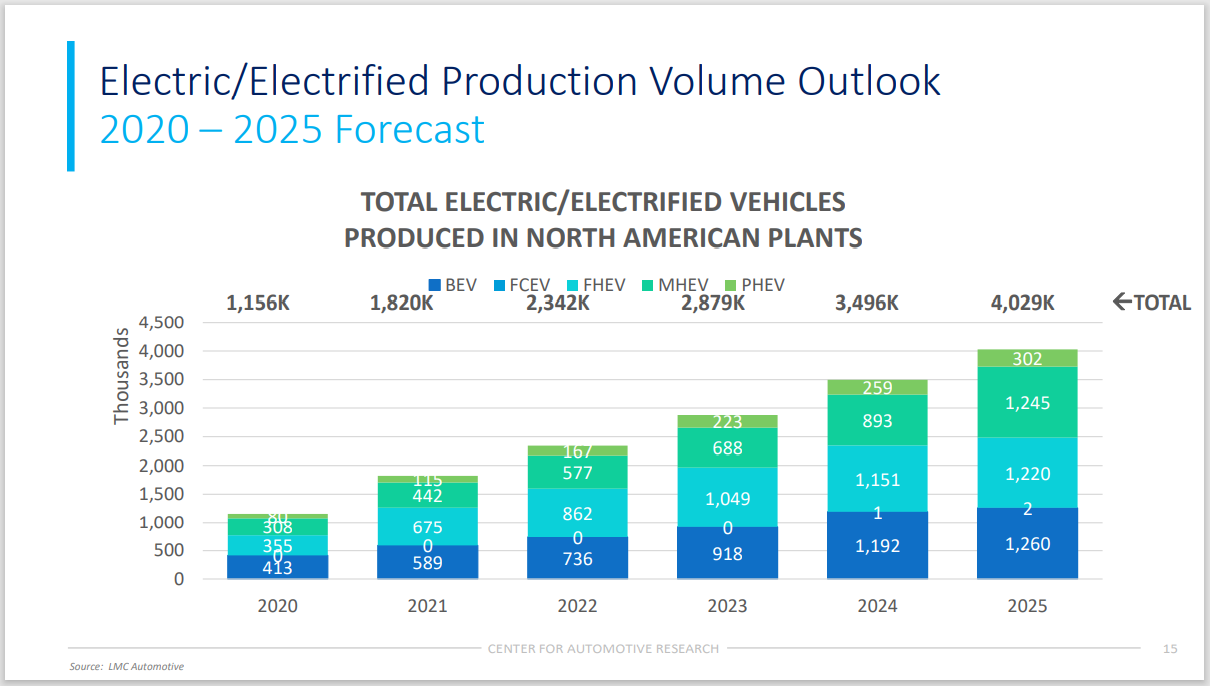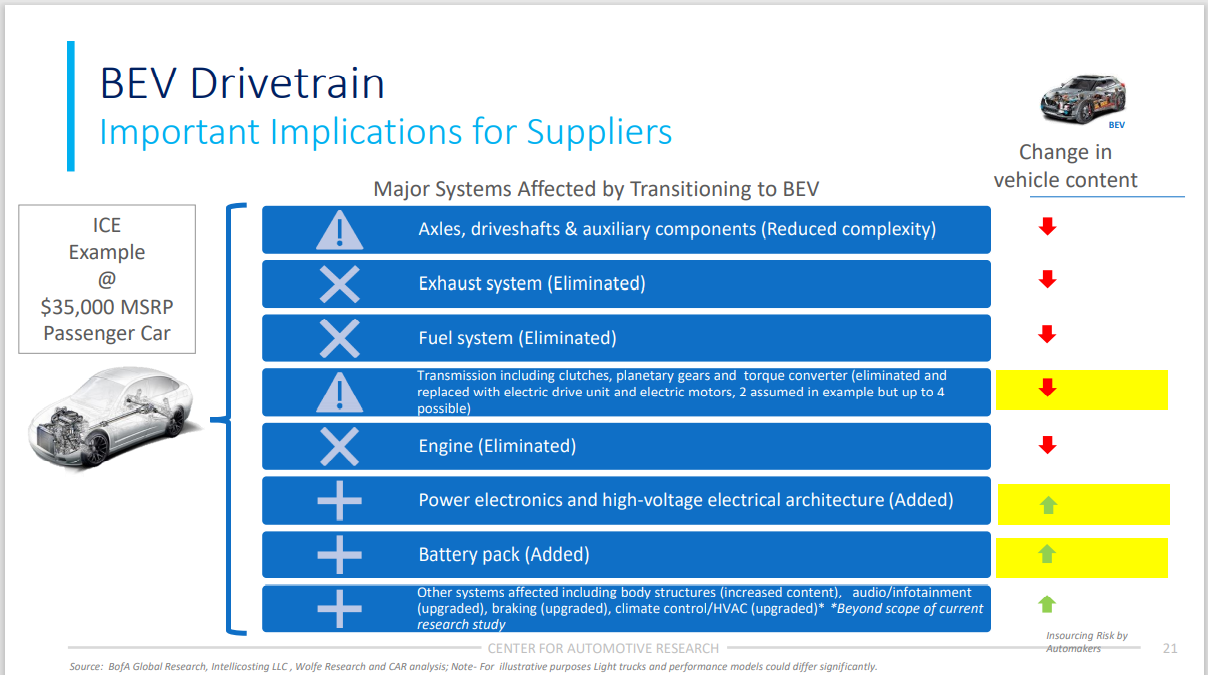Steel Markets

Swiecki: Electric Vehicles’ Time Has Come
Written by Tim Triplett
July 29, 2021
“Electric vehicles are having a moment,” said auto market expert Bernard Swiecki – a moment likely to last for years.
Swiecki’s Center for Automotive Research in Ann Arbor, Mich., is spending much of its time studying the sudden and surging interest in the various forms of low- or zero-emission electric vehicles (EVs), from plug-in hybrids, to pure battery electrics to futuristic fuel cell versions. “The vast majority of automotive investments this year have been somehow linked to either EVs or components. The pace has picked up and shows no signs of slowing,” he said during Steel Market Update’s Community Chat on Wednesday (click here for a recording of the webinar).
The EV market is maturing at incredible speed. Sales of EVs now make up 8% of the light vehicle market. By 2030, the market for vehicles that plug in will reach 20-40% depending on consumer acceptance and government policy decisions such as tax rebates that make electric cars and trucks more affordable, as well as spending on charging stations and other infrastructure investments.
North American carmakers produced 65 electrified models in 2020; that number will top 150 by next year. Total production of EVs in 2021 will double from 1.1 million last year and could hit 4.0 million by 2025. “Product offerings are growing greatly, which means significant changes for the value chain in terms of supply base and materials,” Swiecki noted.

Historically, sales of EVs have cycled up and down with the price of gasoline. “The EV market is growing infinitely faster than fuel prices today. Consumers are buying EVs for the vehicle itself, because it has the attributes they are looking for, not simply to save money,” Swiecki said.
EV production has also disconnected from Detroit. Investors are setting up shop to produce vehicles and batteries in various regions, including the Southwest, which offers a favorable climate and a willing workforce for new business (e.g., SDI’s new steel mill in Sinton, Texas). Which raises the question: If EV production spreads throughout the country, will the traditional automotive supply chain get left behind?
Production of EVs is not as reliant on the traditional providers of components such as internal combustion engines, transmissions and drive trains. But EV makers will need to establish their own value chains for batteries, chassis, electric motors and sophisticated electronics. Swiecki is concerned that during the changeover, automakers will source components from overseas, and it will be difficult for the U.S. to get that foreign business back. “Maybe we should goose the heck out of the market in terms of consumer acceptance and production incentives, so it grows as quickly as possible. There is a certain inertia in supply chains. I am not confident we would regain the employment and economic benefits we would lose during that transition by waiting for the market to grow [on its own].”

The short supply of semiconductors continues to hobble the automotive sector, especially production of chip-heavy EVs. The chip shortage won’t improve until mid or late 2022, Swiecki said. “What gets lost in the equation is that semiconductors are not the only constraint. There are petrochemicals, labor and other shortfalls as well. It’s hard to say to what degree the semiconductor shortage is masking these other issues.”
Automakers have produced and parked untold thousands of cars and trucks with the intention of completing them when the chips become available. Does that pose a threat that the market will be flooded with a revenue-crushing surge of last year’s models at some point? No, Swiecki said, the car companies will be careful to apportion the chips among their new and partially finished vehicles.
So-called “range anxiety” continues to make many consumers reluctant to take the EV plunge. The industry is working to address that problem primarily with lighter, cheaper batteries that are quicker to recharge. The Biden administration’s infrastructure bill, being debated this week in Washington, will fund 500,000 EV charging stations across the country if that line item survives the budget ax.
The EV revolution now under way is not a blip or a fad as in the past, Swiecki concluded. “The pace of growth we have seen leads us to believe this is for real. We are seeing that translated into where the companies are putting their money.”
(Editor’s note: Bernard Swiecki, research director for the Center for Automotive Research, will be a featured panelist during the Steel Market Update Steel Summit, set for Aug. 23-25 in Atlanta. Click here for more information and to register.)
By Tim Triplett, Tim@SteelMarketUpdate.com

Tim Triplett
Read more from Tim TriplettLatest in Steel Markets

USW cheers Evraz NA agreement with Atlas Holdings
The United Steelworkers (USW) labor union celebrated recent news of the signed agreement between Atlas Holdings and Evraz NA in which the Connecticut-based private equity company said it plans to acquire North America’s Evraz facilities.

Steel buyer spirits tempered by soft spot market conditions
Steel sheet buyers report feeling bogged down by the ongoing stresses of stagnant demand, news fatigue, tariff negotiations or implementation timelines, and persistent macroeconomic uncertainty.

Hot-rolled coil buyers continue seeking certainty
Steel market participants contend that buyers will remain in “wait-and-see" mode until some market stability is restored.

Latin American steel advocates warn on cheap import flood
Subsidized Chinese steel imports and cheap steel products from Association of Southeast Asian Nations (ASEAN) entering Latin American (LATAM) are threatening the region's steel market.

CRU: Steel prices fall amid global demand weakness
The forceful headwinds bearing down on steel markets across the globe have created demand challenges and sent prices southward. The US, however, challenged the global trend.
